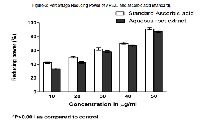Antiulcer And Antioxidant Potential Of Zizyphus jujuba Mill Root Extract In Aspirin And Ethanol Induced Gastric Ulcers.
Keywords:
Antiulcer, Antioxidant potential, Ethanol induced gastric ulcer.Abstract
The root of Zizyphus jujuba Mill. (Rhamnaceae) (ZJ) has been used to treat mouth ulcers as indigenous medicine. However there is no scientific report of its use for protection and treatment of gastric ulcers. The aqueous root extract of ZJ (AREZJ) was evaluated for antiulcerogenic potential in aspirin and ethanol induced ulcer models in Wistar rats along with in vitro antioxidants potential. Single dose toxicity studies were carried out to determine LD50. Two doses i.e. 150 and 250 mg/kg b.wt were evaluated for antiulcer activity by measuring ulcer index and percentage of ulcer healing in two of the ulcer models. Antioxidants activity was estimated in vitro by DPPH, H2O2 free radical scavenging and reducing power assay. Phytocostituents were determined by standard method. Based on ulcer index, percentage protection of 76.92% in aspirin model and 70% in ethanol model were noted with a dose of 250 mg/kg b.wt of AREZJ, whereas standard drug omeprazol (50 mg/kg b.wt) showed 80.77 % and 80 % protection in aspirin and ethanol models respectively. AREZJ showed 89.2% DPPH and 88.5% H2O2 free radical scavenging activity at concentration of 200 μg/ml and 80 μg/ml respectively. AREZJ also exhibited 87.5% reducing power at 50 μg/ml. Phytochemical screening of AREZJ showed presence of alkaloids, carbohydrates, flavanoids, glycosides, proteins and tannins. No mortality was noted till 2500 mg/kg b.wt of AREZJ, indicating higher LD50 value. AREZJ was found to have antiulcerogenic effect, which could be related to its antioxidant potential.
References
. Peng WH, Hsieh MT, Lee YS, Lee YC, Liao J. Anxiolytic effect of seed of Ziziphus jujuba in mouse models of anxiety. J. Ethnophar. 2000; 72: 435-441.
. Lee S, Min B, Lee C, Kim K, Kho Y. Cytotoxic triterpenoids from the fruits of Zizyphus jujuba. Planta Medica. 2003; 69: 18-21.
. Taraneh E, Asna U. Antioxidant components and activity in the peel of Ziziphus jujuba Mill. J. Pharm. Reser. 2012; 5: 2705-2709.
. Kumar S, Ganachari MS, Banappa, Nagoor VS. Antiinflammatory activity of Ziziphus jujuba Lam leaves extract in rats. J. Natu. Remed. 2004; 4(2): 183-185
. Ganachari MS, Shiv K, Bhat KC. Effect of Ziziphus jujube leaves extract on phagocytosis by human neutrophils. J.Natu. Remed. 2004; 41: 47-51.
. Ganachari MS, Shiv K, Bhat KCEffect of Ziziphus jujube leaves extract on phagocytosis by human neutrophils. J. Natu. Remed. 2004; 41: 47-51.
. Ganachari MS, Kumar S. Anti-ulcer properties of Ziziphus jujuba Lam leaves extract in rats. J. Natu. Remed. 2004; 4: 103-08.
. Ganachari MS, Kumar S, Alagawadi KR. Antiobese activity of Ziziphus jujuba Lam leaves extract in dietary obese rats. J. Natu. Remed. 2007; 7: 102-108.
. Gupta RB, Sharma S, Sharma JR, Goyal R. Study on the physico-chemical characters of fruits of some wild and cultivated forms/spp. (Zizpi hus spp.). Haryana J Horticul sci. 2004; 33(3/4): 167-69.
. Mishra KK, Kashyap P, Sawarkar HA, Mule BP, Verma SK, Kumar S. Evaluation of Antifungal Activity of Stones of Ziziphus jujuba for Ringworm infection. Inter. J. Her. Drug Rese. 2012; 1(3): 8-11.
. Shirdel Z, Madani H , Mirbadalzadeh R. Investigation into the hypoglycemic effect of hydroalcoholic extract of Ziziphus Jujuba Leaves on blood glucose and lipids in Alloxan-Induced diabetes in rats. Iran J. Diabe. Lip. Disord. 2009; 13-19.
. Kumar CS, Arutla R, Swaroopa D, Rao KS. Wound healing potential of Ziziphus jujube bark extract on albino rats. Inter. J. reser. Ayur. Pharm. 2012; 3(6).
. Suerbaum S, Michetti P. Helicobacter pylori infection. N. Engl. J. Med. 2002; 347: 1175- 86.
. Hoogerwerf WA, Pasricha PJ. Pharmacotherapy of Gastric Acidity, Peptic Ulcers and Gastroesophageal Relux Disease. In: Brunton L, Lazo J, Parker K, editor. Goodman & Gilman’s: The Pharmacological Basis of Therapeutics. 11th ed. New York: McGraw-Hill Professional.; 2006. p. 972.
. Tripathi KD. Essentials of Medical Pharmacology. 6th ed. New Delhi, India:
Jaypee Brothers Medical Publishers.; 2008.
. Berardi RR, Welage SL. Peptic Ulcer Disease. In: Dipiro JT, Talbert RL, Yees
GC, Matzke GR, Wells GB, Posey ML,editor. Pharmacotherapy: A Pathophysiologic
Approach. 6th ed. New York: McGrawHill.; 2005. p. 632-48.
. Atta AH, Nasr SM, Moumeir SM. Antiulcerogenic effect of some plant extracts. Natu.l
Pro. Radia. 2005; 4(4) July-Aug(article).
. Gohar AA, Zaki AA. Assessment of some Herbal Drugs for Prophylaxis of Peptic Ulcer.
Iran. J. Pharm. Res. 2014; 13(3): 1081-1086.
. Verma VK, Sing N, Saxena P, Sing R. Anti-Ulcer and Antioxidant Activity of Moringa
Oleifera (Lam) Leaves against Aspirin and Ethanol Induced Gastric Ulcer in Rats. Int. Res. J. of
Pharmace. 2012; 2(2): 46-57
. Dharmani P, Mishra PK, Maurya R, Chauhan VS, Palit G. Desmodium gangeticum:a
potent anti-ulcer agent. Ind. J. Exp. Biol. 2005; 43:517-521.
. Molyneux P. The use of the stable free redical diphenylpicrylhydrazyl(DPPH) for
estimating antioxidant activity. Songkl. J. Sci. Technol. 2004; 26: 211-219.
. Elizabeth K, Rao MNA. Oxygen radical scavenging activity of Curcumin. Intern. J.
Pherma. 1990; 58:237-40.
. Shreejayan, Rao MNA. Nitric oxide scavenging by curcuminoids. J. Pharm. Pharmacol.
; 49:105-07.
. Harbone JP. Phytochemical methods: A guide to modern technique of plant Analysis, 1st
ed. London: Chapmann and Hall Ltd.; 1973.
. Chang FK, Leung WK. Peptic ulcer disease. Lancet. 2002; 360: 933-41.
. Alambayan J, Vats M, Sardana S, Sehrawat R. Evaluation of antiulcer activity of roots of
Acacia catechu Willd. (Mimosoideae). J. Pharmaco. Phytoche. 2015; 3(5): 79-84.
. Sannomiya M, Foneca VB, Dasilva MA et al. Flavonoids and antiulcerogenic activity
from Brysonima crassa leaves extract. J Ethnopharm. 2005; 97: 1-6.
. Umamaheshwari M, Asokkumar K, Rathidevi R et al. Antiuler and in vitro antioxidant
activities of Jasminum grandiflorum L. J. Ethnopharmacol. 2007; 110: 464-70.



